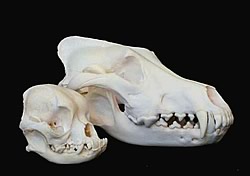Last updated: August 19, 2013
Nhgri Researchers Provide Insights On The Genetics Of Dog Skull Variation
NHGRI researchers provide insights on the genetics of dog skull variation
By Raymond MacDougall
Associate Director of Communications, Division of Intramural Research
 |
Study of dog skull variation conducted at NHGRI's Cancer Genetics Branch is among research leading to insights and methods for exploring both canine, and, by extension, human skull biology and genetics. Elaine A. Ostrander, Ph.D., NIH distinguished investigator and chief or NHGRI's Cancer Genetics Branch (CGB) and Jeffrey J. Schoenebeck, Ph.D., CGB research fellow, are co-authors of a review article in the February issue of Genetics that surveys the progress in their lab and in the field to define the genes and pathways that determine canine skull shape and development.
A dog's craniofacial diversity is the result of continual human intervention in natural selection, say the authors. They discuss the origins of dog skull shapes in terms of history and biology and recent advances in understanding the genetics of canine skull shapes.
The research has accelerated in the eight years since the dog genome was mapped. By mapping gene variations that lead to distinct morphological traits, the researchers are able to identify new roles for genes now being studied, even those not previously implicated in cranium development.
The authors explain how genetic study of canine physiology may lead to advances in addressing human dental, eye and other physiological problems.
To read the article in Genetics, go to: The Genetics of Canine Skull Shape Variation [genetics.org]
Last Reviewed: August 19, 2013
